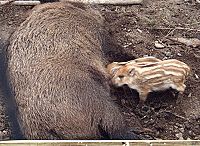
Juvenile (organism)
Encyclopedia
A juvenile is an individual organism
that has not yet reached its adult
form, sexual maturity
or size. Juveniles sometimes look very different from the adult form, particularly in terms of their colour. In many organisms the juvenile has a different name from the adult (see also List of animal names).
Some organisms reach maturity in a short metamorphosis
, such as eclosion in many insect
s. For others, the transition from juvenile to fully mature is a more prolonged process – puberty
for example. In such cases, juveniles during this transformation are sometimes called subadults.
Many invertebrate
s, on reaching the adult stage, are fully mature and their development and growth stops. "Juvenile" refers to the larva
or comparable stages in such taxa.
In vertebrate
s and some invertebrates (e.g. spider
s), larval forms (e.g. tadpole
s) are usually considered a development stage of their own, and "juvenile" refers to a post-larval stage that is not fully grown and not sexually mature. In amniote
s and most plant
s, the embryo
represents the larval stage. Here, "juvenile" in general applies to the time between hatching/birth/germination and reaching maturity.

Organism
In biology, an organism is any contiguous living system . In at least some form, all organisms are capable of response to stimuli, reproduction, growth and development, and maintenance of homoeostasis as a stable whole.An organism may either be unicellular or, as in the case of humans, comprise...
that has not yet reached its adult
Adult
An adult is a human being or living organism that is of relatively mature age, typically associated with sexual maturity and the attainment of reproductive age....
form, sexual maturity
Sexual maturity
Sexual maturity is the age or stage when an organism can reproduce. It is sometimes considered synonymous with adulthood, though the two are distinct...
or size. Juveniles sometimes look very different from the adult form, particularly in terms of their colour. In many organisms the juvenile has a different name from the adult (see also List of animal names).
Some organisms reach maturity in a short metamorphosis
Metamorphosis
Metamorphosis is a biological process by which an animal physically develops after birth or hatching, involving a conspicuous and relatively abrupt change in the animal's body structure through cell growth and differentiation...
, such as eclosion in many insect
Insect
Insects are a class of living creatures within the arthropods that have a chitinous exoskeleton, a three-part body , three pairs of jointed legs, compound eyes, and two antennae...
s. For others, the transition from juvenile to fully mature is a more prolonged process – puberty
Puberty
Puberty is the process of physical changes by which a child's body matures into an adult body capable of reproduction, as initiated by hormonal signals from the brain to the gonads; the ovaries in a girl, the testes in a boy...
for example. In such cases, juveniles during this transformation are sometimes called subadults.
Many invertebrate
Invertebrate
An invertebrate is an animal without a backbone. The group includes 97% of all animal species – all animals except those in the chordate subphylum Vertebrata .Invertebrates form a paraphyletic group...
s, on reaching the adult stage, are fully mature and their development and growth stops. "Juvenile" refers to the larva
Larva
A larva is a distinct juvenile form many animals undergo before metamorphosis into adults. Animals with indirect development such as insects, amphibians, or cnidarians typically have a larval phase of their life cycle...
or comparable stages in such taxa.
In vertebrate
Vertebrate
Vertebrates are animals that are members of the subphylum Vertebrata . Vertebrates are the largest group of chordates, with currently about 58,000 species described. Vertebrates include the jawless fishes, bony fishes, sharks and rays, amphibians, reptiles, mammals, and birds...
s and some invertebrates (e.g. spider
Spider
Spiders are air-breathing arthropods that have eight legs, and chelicerae with fangs that inject venom. They are the largest order of arachnids and rank seventh in total species diversity among all other groups of organisms...
s), larval forms (e.g. tadpole
Tadpole
A tadpole or polliwog is the wholly aquatic larval stage in the life cycle of an amphibian, particularly that of a frog or toad.- Appellation :...
s) are usually considered a development stage of their own, and "juvenile" refers to a post-larval stage that is not fully grown and not sexually mature. In amniote
Amniote
The amniotes are a group of tetrapods that have a terrestrially adapted egg. They include synapsids and sauropsids , as well as their fossil ancestors. Amniote embryos, whether laid as eggs or carried by the female, are protected and aided by several extensive membranes...
s and most plant
Plant
Plants are living organisms belonging to the kingdom Plantae. Precise definitions of the kingdom vary, but as the term is used here, plants include familiar organisms such as trees, flowers, herbs, bushes, grasses, vines, ferns, mosses, and green algae. The group is also called green plants or...
s, the embryo
Embryo
An embryo is a multicellular diploid eukaryote in its earliest stage of development, from the time of first cell division until birth, hatching, or germination...
represents the larval stage. Here, "juvenile" in general applies to the time between hatching/birth/germination and reaching maturity.


